Today, we’re talking about tips on how to improve your songwriting.
Songwriting is the process of composing a track. From melody to the chord progression, from tonality to musicality of the tune, all elements that compose and play a role in telling the story of the song are part of the songwriting process.
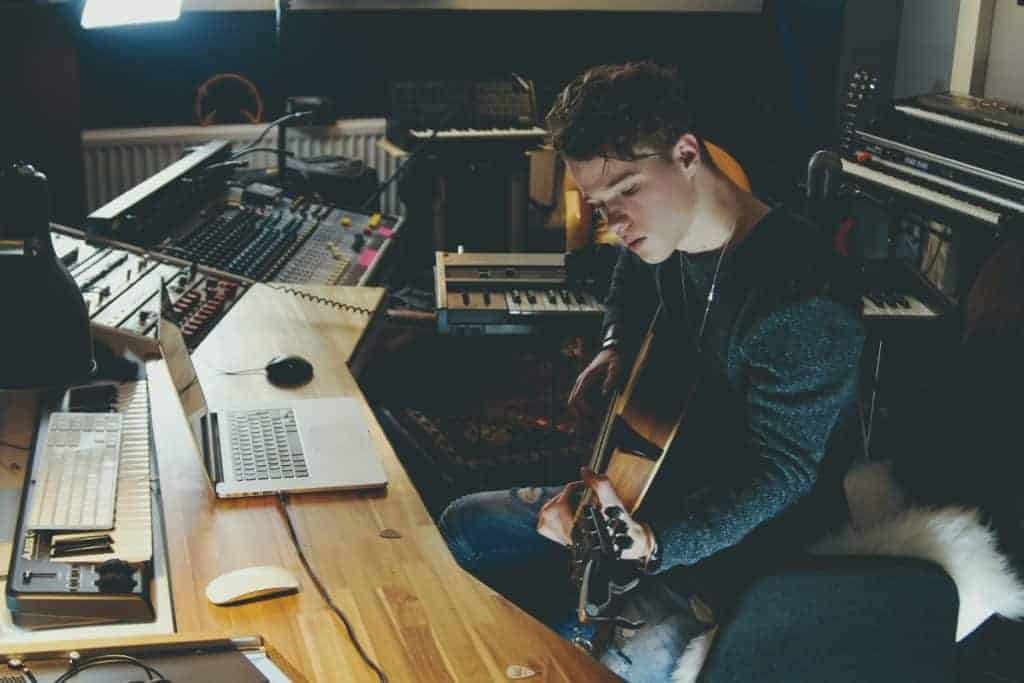
Therefore, songwriting could be a REALLY vast subject to talk about. Indeed, but today we’re talking about tips on generating ideas for your songs and how to make them more fluid into your creative process.
In that sense, this post will not be only about hands-on writing skills, but also about habits and mindset you should have as a music producer or musician to generate the best ideas you can with the tools you currently have.
You can watch some of these ideas in the video below:
Let’s go straight to the point and here’s what we’re talking about today:
Let’s dive right in
Hands-On Songwriting Tips
Reverse a Song You Like
Have you ever tried reversing a song or a chord progression you like and checked what came out of it? If you haven’t, you’re definitely missing out!
Pick a song you really like, try to find moments where you can clearly listen to the melody without the kick, e.g. during the break, and reverse it. You can do the same with any midi you choose. To quickly show how it works, I did this with my track INCA and listen here to the amazing melody that I got:
Use Midi Packs
If you’re lost and don’t know where to go, why not use midis as a starting point? I always recommend that you change them somehow so they are not exactly like the chord progression you found. In my track ‘Find My Own’, these are the chords I’ve used during drop 2:

And below you can see the midi where I got it from.

In addition to extending, changing the rhythm, and changing the top melody, I changed the key from C to F#. Change it a bit, make it less obvious, and just go for it.
Start With a Vocal
A songwriting technique that my great friend and alumni, winner of the Anjunabeats Contest in 2017, Joel Freck told me, start with an acapella and try to create something on top of it. Later, you will delete this acapella, but use it in the beginning to develop your top melodies and chord progressions
Pick an acapella you like and start writing on top of it. If you don’t have an acapella, you can try starting a remix of a song that could provide you with an acapella, as mentioned here. In this post, however, let’s work with Reload’s acapella:
Sometimes this works, sometimes it doesn’t, but you can try loads of different vocals until it does.
To show you that it works, I’ve created a melody for this vocal, and it goes like this:

Use Hooktheory or Plugins
If you’re not feeling like playing anything, why not use some tools to help you? If that’s your case, Hooktheory & Hookpad are here to save you!
When you open Hookpad, it gives you the opportunity to create chords, complex or not, with the press of a button.
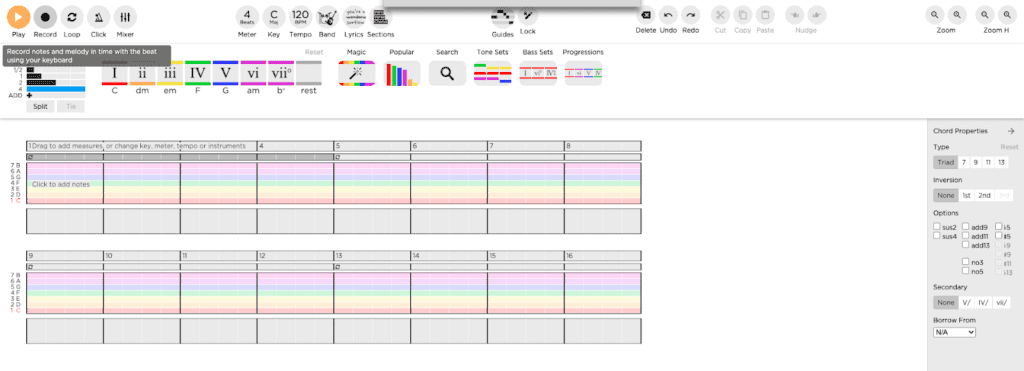
Just press any of the chords above, from I to VII, and it will generate that chord in that scale, which you can also change. Combine it with the acapella technique above, and you can quickly try different chords on top of your vocal (Thanks Joel).
Here is a progression I’ve created using it that I really liked:

Hooktheory has a paid version that lets you convert your progression to midi, but I did it by myself and got this:

You can also try using plugin like Captain Chords or Scaler2, which essentially will help you with generating chords as well.
Repurpose a Genre
What if you pick a melody you’ve listened to in classical musical, twist it a bit, and bring it to electronic music?
For example, while writing this post, I heard this piece and I can’t wait to play it on my keyboards:
Not sure if anything will happen, but LOTS of good chords in there so I’ll try to repurpose them into something different. Blume is a great channel to listen to this kind of track and I can say that two of my next tracks have repurposed chords from Blume’s playlists.
Look at an Image or a Word

Look at this image above. To me, it gives the feeling the day is ending, and it’s getting darker but it’s a beautiful and rich image. It gives me a sense of hope (the sun), but at the same time, it’s a sunset, so a downwards progression would be the best fit.
I took this concept to the test and wrote something based on it. Here’s what I got:
Doesn’t it translate amazingly with this picture? Now try it yourself!
I’ve recently met a friend called Bjorn, and he said to me that he wrote a full album looking at paintings. The one that I really liked was La Route de Louveciennes:
This song was inspired by the painting from Camille Pissarro – La Route de Louveciennes:

Play an Instrument
Whenever I want to write something, I sit to play songs that I like playing and this normally triggers my creative songwriting to start working, eventually leading me new melodies.
Fur Elise is usually how I warm up my hands and then I sometimes move to Maroon 5 – This Love or Gabrielle Aplin – My Mistake, or Tears For Fears – Mad World:
After warming up, I move to play tracks I love in my genre of focus. After 15-30 min of playing several songs, I try to create something and it normally works out.
The exposure to folk songs and to electronic songs somehow create some spark in my head and that’s how I’ve created the chords above that you’ve just listened to and my track Never Letting Go. Something about being in contact with a real instrument helps you play chords and ideas you normally wouldn’t be able to while just drawing notes.
Mess Around With Your Sample Packs
Some preset packs and sample packs come with Melody/Music Loops, which you can use inside your project.
Listen to the audio below, which was in one sample pack that I’ve downloaded from the Anjuna Contest:
Now listen to the build-up of Find My Own:
Why not? You can read more about how you can be creative with sample packs in this post.
Start With the Bassline
Sometimes, starting with the bassline can do you wonders to your songwriting.
Chords are complex and involve playing three to several notes at the same time. Basslines, on the other hand, are single noted and are way easier to come up with. This way, your writing will be less complex since it won’t require you to set up different voices for the same piece.
Pick one sine wave or saw wave, and just play a progression. After finding the bass progression, you replicate the bass notes to chords and add voicing, and you can also enhance your bass progressions with this post.
Enhance Your Chord Progression
Sometimes your chord progression is not perfect, but what you need are just some chord enhancements. These are some enhancements that you should follow, which I describe a bit better in this post:
- Time Shifts: You can anticipate some notes so they play a little ahead of the 4/4 tempo, which creates movement and urgency to the progression;
- Inversions: Making sure that your chords are playing the same octave of the piano by shifting some notes one octave up or down, avoiding the drastic sound differences when playing a VI chord and a III chord. Look at the example below:Original progression:

Inverted Chord Progression:

- Adding 2nd, 4th, 6th, or 7th notes: Enhance the voicing of your chords by playing an additional 7th with one chord and a 4th with another chord could enhance the tonality and richness of the progression.
Use a Greek Mode to Write a Progression
If you don’t know what a Greek Mode is, please watch the video below:
In a nutshell, the 7 Greek modes are different interpretations of the major scale. The difference between a C Major (C-D-E-F-G-A-B-C) and a D Dorian (D-E-F-G-A-B-C-D) is not the scale they play, since they both play the same notes, but which notes are emphasized.
By using the different modes, you’ll be able to not only expand your options beyond the Minor and Major scale, but it could also bring new sounds and characters to your tracks.
My favorite mode, for example, is the Dorian Mode. I’ve written multiple songs on it as well as many artists, like Daft Punk in Get Lucky (B Dorian) or Billie Jean by Michale Jackson (F# Dorian), and it’s the one I recommend you to try when creating new songs.
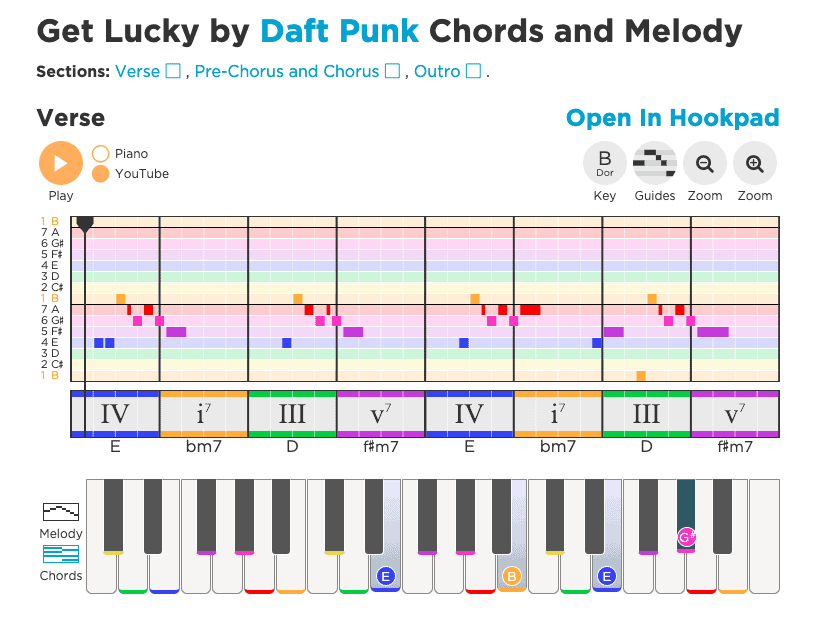
Reference Tracks Your Like
Whenever I’m starting any new song, I make a Spotify playlist of songs I could reference. Sometimes I enter the main playlists of that genre and check what is the mood and elements of the top tracks in there.
For example, if you’re a house producer, you could enter at Dance Party and check which are the main songs there. Try to find songs you like and put them in a new playlist and try to understand why you like these songs.
- Is it the bassline?
- Is it the chord progression?
- Or is it the mood or structure of the track?
Whatever the reason is, you can try to capture that and apply it to your track. Simply putting yourself into the vibe of what you want to create may spark some new melodies in your head. You can read more about this over here.
Mindset and Workflow Tips for Songwriting
Write With a Plan
No matter the genre you’re working on, you need a vision or plan of your song before you even start making it:
- I want to make a progressive track that will follow this structure;
- I want to make a house track with two drops and two breaks;
- My drops will be, at most, 1 min long
This doesn’t mean you’ll have to stick to the plan all the way through. However, having a plan from the beginning for what you’re making will give you a vision of how to progress your song, which helps limit your project scope and could actually make you more creative and effective when writing your track.
Look below at how Stay With Me was developed entirely before I even started producing it:
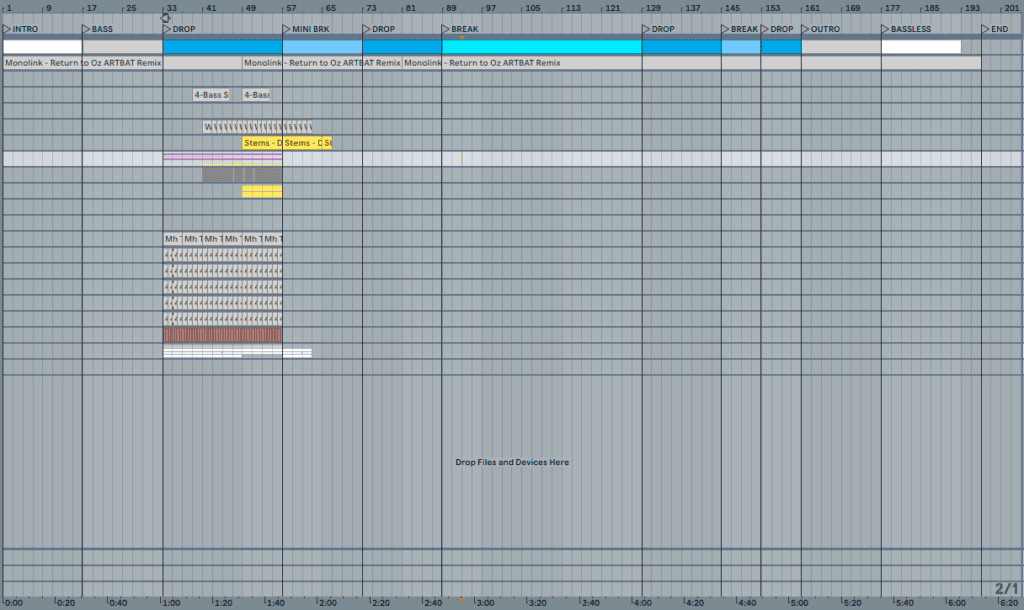
Focus on One Key (Only)
I always create my tracks in G or F# minor, and only after I’ve decided that I loved them that I start seeking other keys. Beethoven, for example, was characteristically known for his compositions in C minor, while Mozart preferred G minor to write tragic compositions.
By only focusing on two keys, it’s so much easier to play chords since I know these keys inside out and I know all the chord variations from memory, which makes playing more natural and, therefore, more ideas come out of “practices”. It makes something uncomfortable (creating) a little bit more comfortable.
Collaborate With a Friend
There’s nothing more creative and liberating creatively than collaborating with someone else when writing new songs.
Collaborating is a good example where 1 + 1 can equal 3 or even more since you’re uniting your experiences and your cognitive abilities with your partner, which can result in something definitely unexpected from both of you.
When writing Aisha with Quizzow, I first started the song by myself. The A&R from Enhanced rejected the first version, and months later I invited Quizzow to join. After what they have done in the track, along with some further inputs and rearrangements from myself, the song was accepted by the same A&R from Enhanced Music, which I definitely wouldn’t be able to achieve by myself alone.
Three things I recommend you to do when collaborating with a friend:
- Make sure your intentions match and that your goals are aligned;
- Collaboration is a compromise. Not all your ideas will be implemented, all not all ideas from your partner should be done as well, but all should be tested and discussed. There’s no dumb idea!;
- Make sure to establish a workflow that works for both of you in terms of working on different DAW and how the creative process is going to be done.
Create Two Melodies Every Week
You have to set aside 2 hours weekly to write new melodies. Quantity over quality principle applied to songwriting to the fullest.
Doesn’t matter if they are good melodies, you have to create two melodies, at least, every week, and so have I done.
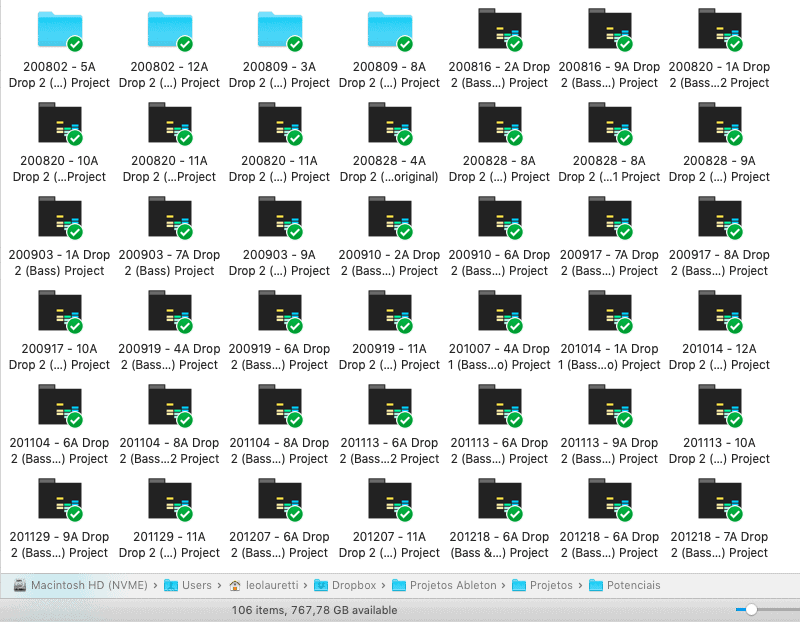
Not only will you have a buffer of countless ideas you can work out of right now for your next, but the momentum you’ll get from always brainstorming will also most definitely kill any sort of writer’s block you may be going through right now, something you can read more on this post.
This will help you stay sharp, keep your creative flow going and choose only from the best ideas you had. If you want to find out more ways to enhance your creativity, read this post.
Piano, Kick, and Bass
Whenever you sit down to create, you should just use piano, kick, and bass. I’ve written about this in this post about creativity, which mentions that using only these three elements help you decide whether a melody is good without any fancy sound design. The two main reasons why I recommend you to do this are:
- If the melody, with these rawest elements possible, is enticing enough to you, then it is probably something to keep an eye on because once you develop the sound design, it will become even better;
- It makes comparing melodies a lot easier. When you sit down to compare the melodies you’ve created in the past month, they all will have the same sound design, so you’ll compare apples to apples and, most likely, will choose the best progression from them without any sound design bias.
Make a Template in Your DAW
For both aliases that I’m working on, House music and Trance, I have a “Songwriting Template” that I open when I sit down to create something new. It consists of a Kick, hit hats, fx, Claps, Piano, and Bass, but always the same presets.
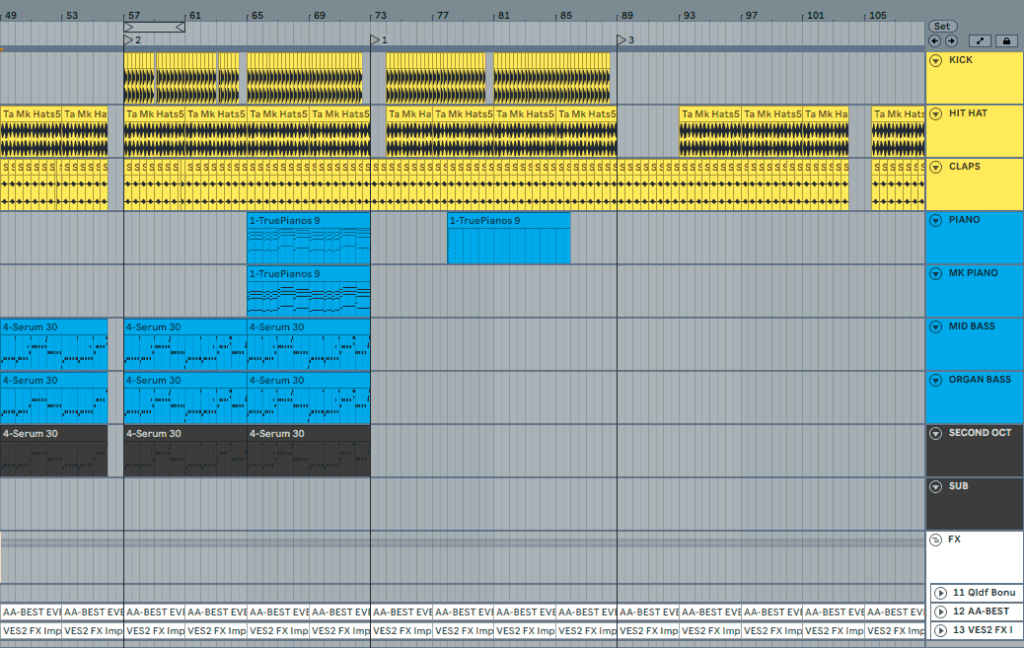
Since these additional elements (FX, Claps, Hit Hats) will be added down the road, why not add them from the start? It could serve as an idea tester project. Therefore, by having them there, you’ll have a better sense of how your idea will turn out after it’s fully sound designed.
If you’re working on Future Bass, for example, make a template with a standard bass, standard chords, standard drums, and whenever you have a new idea, test it in your template so you can have a feel of it fully developed.
Break the Habit
Do you always write your melodies in the same room? Is it always during the weekends? Is it always during the night? Normally when you’re relaxed?
What if you wrote your melodies:
- At your kitchen?
- During the opposite time in which you normally do it?
- When you’re stressed out or mad?
Breaking the habit helps you create new associations in your brain, which can help you develop your creativity and, therefore, write better compositions. And you can go further along with that:
- Always write in F# Minor? Then compose in F# Major!
- Always use a piano? Then, choose a pad!
Take Breaks
Different from what many would say, taking small breaks between tasks is HIGHLY productive time since taking breaks helps you recharge and digest the information you’ve recently fed your mind with, which is really important to your songwriting.
If you don’t take breaks, your mind can go into stress overload, your ears could become biased and, consequently, your body can start releasing fight or flight responses, which will deteriorate your creativity in the short term.
Therefore, whenever you sit down to compose new tunes, after 1h30/2h of work, take a break and come back later. A small 5-minute walk is capable of recharging your energy and bring you back to your highest physical and mental level, so don’t let yourself go beyond these marks.

I Want to Hear from You Now!
These are all the 20 songwriting techniques that I mostly use when creating new songs.
Which of these 20 tips will you try first?
Mindset techniques or hands-on songwriting techniques?
Let me know in the comments below!
Create Two Melodies Every Week- sounds like a good goal for 2021.
That’s truly a winner to me man!
I like to steal chords from other songs and write my own melodies on top of them. That way, no one can ever say, “your chords don’t work” which is sometimes a problem when you are not trying to trap yourself in the confines of Diatonic music theory.